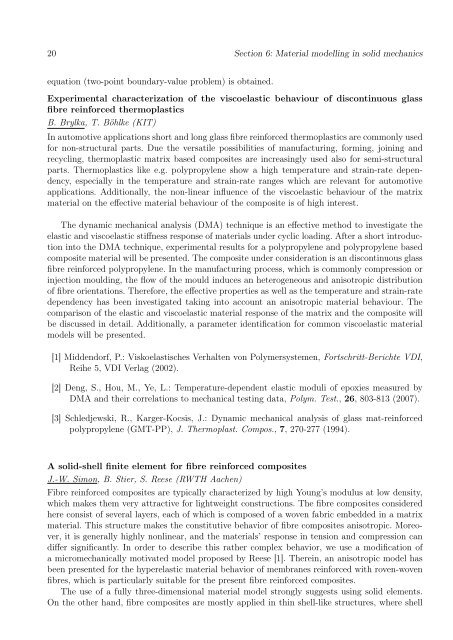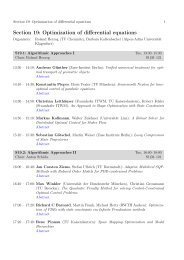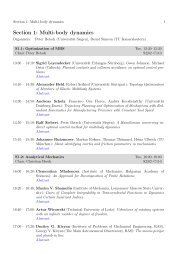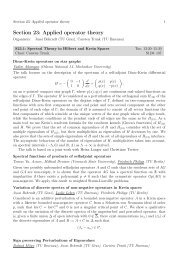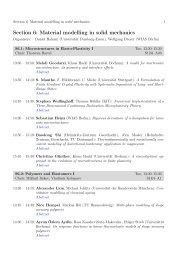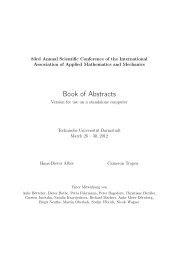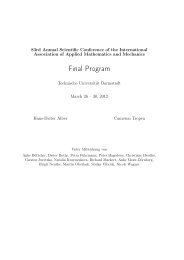Section 6: Material modelling in solid mechanics - GAMM 2012
Section 6: Material modelling in solid mechanics - GAMM 2012
Section 6: Material modelling in solid mechanics - GAMM 2012
Create successful ePaper yourself
Turn your PDF publications into a flip-book with our unique Google optimized e-Paper software.
20 <strong>Section</strong> 6: <strong>Material</strong> <strong>modell<strong>in</strong>g</strong> <strong>in</strong> <strong>solid</strong> <strong>mechanics</strong><br />
equation (two-po<strong>in</strong>t boundary-value problem) is obta<strong>in</strong>ed.<br />
Experimental characterization of the viscoelastic behaviour of discont<strong>in</strong>uous glass<br />
fibre re<strong>in</strong>forced thermoplastics<br />
B. Brylka, T. Böhlke (KIT)<br />
In automotive applications short and long glass fibre re<strong>in</strong>forced thermoplastics are commonly used<br />
for non-structural parts. Due the versatile possibilities of manufactur<strong>in</strong>g, form<strong>in</strong>g, jo<strong>in</strong><strong>in</strong>g and<br />
recycl<strong>in</strong>g, thermoplastic matrix based composites are <strong>in</strong>creas<strong>in</strong>gly used also for semi-structural<br />
parts. Thermoplastics like e.g. polypropylene show a high temperature and stra<strong>in</strong>-rate dependency,<br />
especially <strong>in</strong> the temperature and stra<strong>in</strong>-rate ranges which are relevant for automotive<br />
applications. Additionally, the non-l<strong>in</strong>ear <strong>in</strong>fluence of the viscoelastic behaviour of the matrix<br />
material on the effective material behaviour of the composite is of high <strong>in</strong>terest.<br />
The dynamic mechanical analysis (DMA) technique is an effective method to <strong>in</strong>vestigate the<br />
elastic and viscoelastic stiffness response of materials under cyclic load<strong>in</strong>g. After a short <strong>in</strong>troduction<br />
<strong>in</strong>to the DMA technique, experimental results for a polypropylene and polypropylene based<br />
composite material will be presented. The composite under consideration is an discont<strong>in</strong>uous glass<br />
fibre re<strong>in</strong>forced polypropylene. In the manufactur<strong>in</strong>g process, which is commonly compression or<br />
<strong>in</strong>jection mould<strong>in</strong>g, the flow of the mould <strong>in</strong>duces an heterogeneous and anisotropic distribution<br />
of fibre orientations. Therefore, the effective properties as well as the temperature and stra<strong>in</strong>-rate<br />
dependency has been <strong>in</strong>vestigated tak<strong>in</strong>g <strong>in</strong>to account an anisotropic material behaviour. The<br />
comparison of the elastic and viscoelastic material response of the matrix and the composite will<br />
be discussed <strong>in</strong> detail. Additionally, a parameter identification for common viscoelastic material<br />
models will be presented.<br />
[1] Middendorf, P.: Viskoelastisches Verhalten von Polymersystemen, Fortschritt-Berichte VDI,<br />
Reihe 5, VDI Verlag (2002).<br />
[2] Deng, S., Hou, M., Ye, L.: Temperature-dependent elastic moduli of epoxies measured by<br />
DMA and their correlations to mechanical test<strong>in</strong>g data, Polym. Test., 26, 803-813 (2007).<br />
[3] Schledjewski, R., Karger-Kocsis, J.: Dynamic mechanical analysis of glass mat-re<strong>in</strong>forced<br />
polypropylene (GMT-PP), J. Thermoplast. Compos., 7, 270-277 (1994).<br />
A <strong>solid</strong>-shell f<strong>in</strong>ite element for fibre re<strong>in</strong>forced composites<br />
J.-W. Simon, B. Stier, S. Reese (RWTH Aachen)<br />
Fibre re<strong>in</strong>forced composites are typically characterized by high Young’s modulus at low density,<br />
which makes them very attractive for lightweight constructions. The fibre composites considered<br />
here consist of several layers, each of which is composed of a woven fabric embedded <strong>in</strong> a matrix<br />
material. This structure makes the constitutive behavior of fibre composites anisotropic. Moreover,<br />
it is generally highly nonl<strong>in</strong>ear, and the materials’ response <strong>in</strong> tension and compression can<br />
differ significantly. In order to describe this rather complex behavior, we use a modification of<br />
a micromechanically motivated model proposed by Reese [1]. There<strong>in</strong>, an anisotropic model has<br />
been presented for the hyperelastic material behavior of membranes re<strong>in</strong>forced with roven-woven<br />
fibres, which is particularly suitable for the present fibre re<strong>in</strong>forced composites.<br />
The use of a fully three-dimensional material model strongly suggests us<strong>in</strong>g <strong>solid</strong> elements.<br />
On the other hand, fibre composites are mostly applied <strong>in</strong> th<strong>in</strong> shell-like structures, where shell


